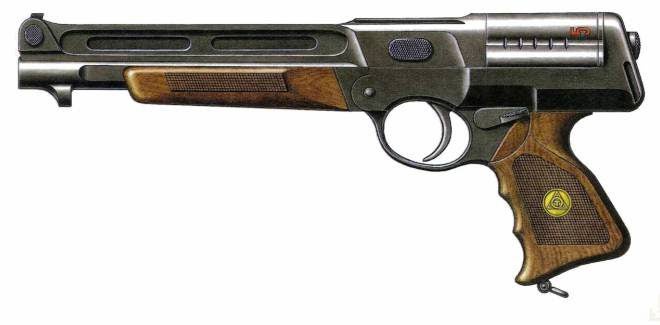As you may remember we’ve already talked about the Soviet “space guns” (firearms developed to issue to astronauts) in the past. Particularly we had a couple of posts on TFB about the TP-82. It was officially adopted and was issued to Soviet astronaut since early ’80s. In this article, we’ll take a look at another such firearm, which was not adopted, yet it is pretty interesting in terms of its mechanism and the history of firearms development.
So why they even needed a gun for astronauts? The main purpose of such а gun is the survival role. The need of such firearm became clear when in 1965 “Voskhod-2” spacecraft had to do an emergency landing. The two crew members of Voskhod-2 had to wait two days until they were found and evacuated. So when you land in the middle of nowhere, you need something to hunt with and defend yourself from predators. At that time astronauts were issued Makarov pistols, which didn’t fit the survival gun role very well. In 1979 Alexey Leonov (the same man who first was in the open space) officially pointed the need of such a gun.
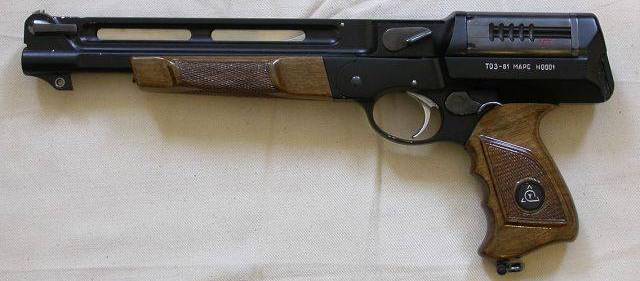
Shortly after that, Tula Arms Plant (TOZ – Tulskiy Oruzheyniy Zavod) started the development of a revolver, which they called TOZ-81 “Mars”. The design idea of this revolver was offered by a famous Soviet gun writer and firearms historian Alexander Zhuk. You may have seen the “Illustrated Encyclopedia of Handguns” written by A.B. Zhuk, which almost entirely consists of firearm drawings with short descriptions. There is an English translation of this book. So the Tula factory formed a designing team, which would work on this gun. A. Zhuk and several firearms designers and engineers were the main members of that team. Zhuk drew the initial sketch of his idea of space revolver. Interestingly, the team first made a plastic mockup of the gun and submitted for final approval of the concept. Only after getting the design approved, they started to make the actual gun.
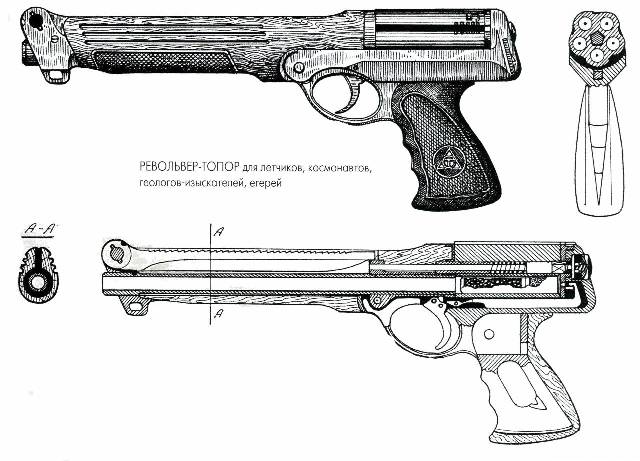
The early drawing of Zhuk’s revolver idea. It was not even called Mars yet. Instead, the designer initially called it “Topor” (means “ax” in Russian). The text on the image says that the revolver was to be used by pilots, astronauts, geologists and gamekeepers.
As you can see the Mars revolver has an unusual location of the cylinder – it is above the grip. This layout allows to have a better-balanced gun and efficiently use the overall length of the gun. In fact, the barrel length (10.25″ (260mm)) and chamber length (3″ (76mm)) combined almost equal the overall length of the gun (14″ (355mm)) leaving only 3/4″ of length for the breech portion. So it is something like a “semi-bullpup revolver” (feel free to criticize me for this expression). I just hope government organizations like ATF don’t adopt my nonsense firearm classification term.
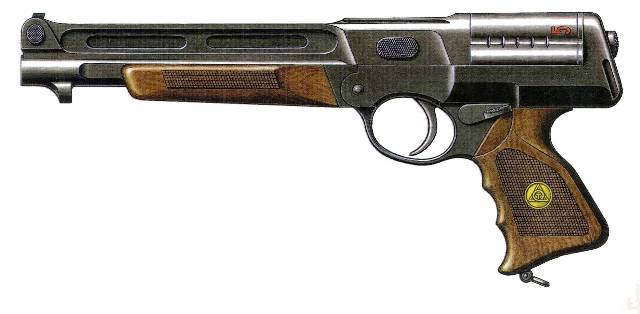
Another drawing of Mars revolver by A. Zhuk.
Another distinctive feature of the revolver is the lower positioned barrel, much like in Chiappa Rhino revolvers.The lowered bore axis helps to fight the muzzle flip. The revolver was also a break action design and was chambered in two calibers – .410 bore and 5.45x39mm.
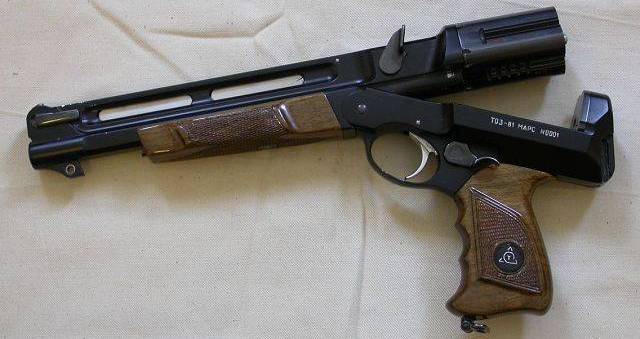
Mars revolver’s frame houses the trigger mechanism and the breech block (behind the cylinder). It has a very basic and simple double action only trigger. Mars has non-adjustable front and rear sights. The barrel and cylinder assembly has a wooden forearm and attaches to the frame by a pin, which becomes its pivot point. At the rear of the frame, right behind the breech, the gun has a stock mounting rail.

The stock consists of an aluminum alloy tube with the attachment slot. It has a wooden cheek piece and a polymer buttstock. There was also an emergency radio transmitter built into the stock, which once activated would send an SOS signal. The revolver had also a folding bayonet. It was folded and stored over the barrel and could be deployed to be used as a bayonet, knife or saw.

The barrel is made as a sleeve which is then inserted into the jacket. In order to break the action open, there was a lever right in front of the cylinder. The gun was equipped with two barrels. One barrel was rifled and another was a smoothbore one for 5.45x39mm and .410 bore respectively. The .410 shells were loaded with buckshot or single flechette projectiles (also possibly signal ones). The 5.45x39mm cartridges were loaded with special expanding bullets. Barrel change did not require any tools and could be easily done in field conditions.
The cylinder is a five shot one. Interestingly, chambers are numbered (1 to 5), which was done to see the amount of remaining ammunition in the cylinder. I assume this could only work if the loaded cylinder is dialed so that it would say the correct amount of ammunition.
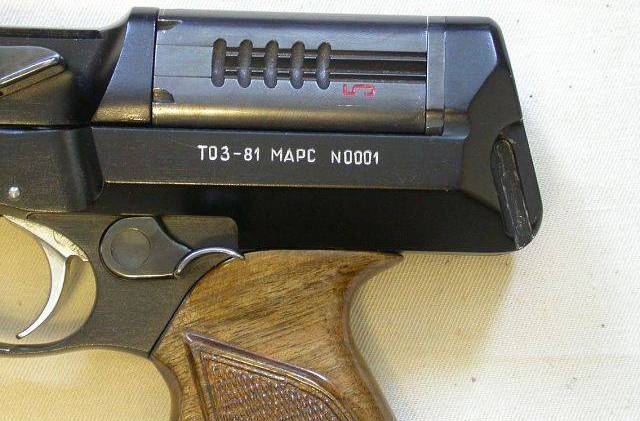
The gun also had a sling and was kept in a box with the stock detached.
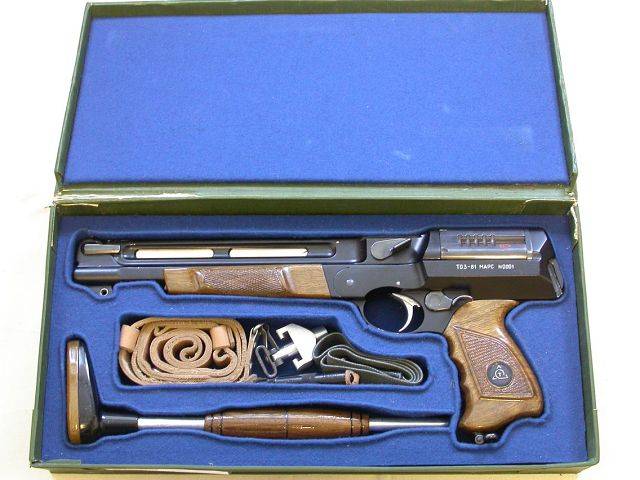
There was only one version of Mars revolver ever made (serial number N0001). The gun was tested, but the three barrel TP-82 was eventually chosen and adopted. It is not clear why it was exactly dropped from the trials. According to Alexander Zhuk, the problem was the .410 bore chambering, which was not too popular in the Soviet Union. That’s why they chose the TP-82, because it had smoothbore barrels chambered in 32 gauge, which was a far more popular cartridge. I don’t think it was the only reason, because who would care about the popularity of the caliber of such a rare gun, which would be made in very small quantities. I think it would be more attractive to have the gun in somewhat weird (for them) .410 bore, but with five shot capacity (plus probably lighter weight).
According to another theory, the simplicity and reliability were the main requirements. So, although revolvers are not complicated firearms, they are definitely not as simple and reliable as break action multi-barrel guns which TP-82 was. Anyway, the gun was rejected and the only made sample was sent to Tula State Arms Museum, where it is kept until today.
Sources:
www.topwar.ru
Tula State Arms Museum
 Your Privacy Choices
Your Privacy Choices
